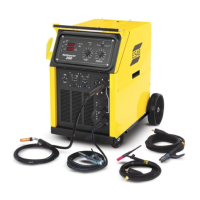44
Comply with all ventilation, re and other safety requirements for arc welding as
established in the SAFETY Section at the front of this manual.
WARNING
4.5 HANDLING THE TIG TORCH
Starting the Arc
There is nothing dicult or technical about starting an arc in the proper manner. We recommend the particular procedure
outlined briey below, to ensure maximum protection of the workpiece from the atmosphere at the start of welding opera-
tions. In DC welding, when striking an arc the electrode must touch the workpiece in order for the arc to start. As soon as
the arc is struck, withdraw the electrode approximately 1/8 inch above the workpiece to avoid contaminating the electrode
in the molten puddle.
To strike an arc, rst turn on the power supply and hold the torch in a horizontal position about 1 inch above the workpiece
or starting block, as shown in Example A below. Then quickly swing the end of the torch down toward the workpiece, so
that the end of the electrode touches the plate. The arc will then strike. Once the electrode “scratches” the plate retract the
torch approximately 1/8”. This will establish the arc.
The arc can be struck on the workpiece itself or on a heavy piece of copper or scrap steel, and then carried to the starting
point of the weld. Do not use a carbon block for starting the arc, as the electrode becomes contaminated causing the arc
to wander. When starting to weld with a hot electrode, the action must be very rapid as the arc tends to strike before the
torch is in proper welding position.
To stop an arc, merely snap the electrode quickly back up to the horizontal position. This motion must be made rapidly so
the arc will not mar or damage the weld surface or workpiece.
The use of hand or foot controls allows the operator to strike the arc, vary welding current and terminate the arc without
moving the torch. This is strongly recommended for proper TIG welding.
Example A
Example B
SECTION 4 OPERATION

